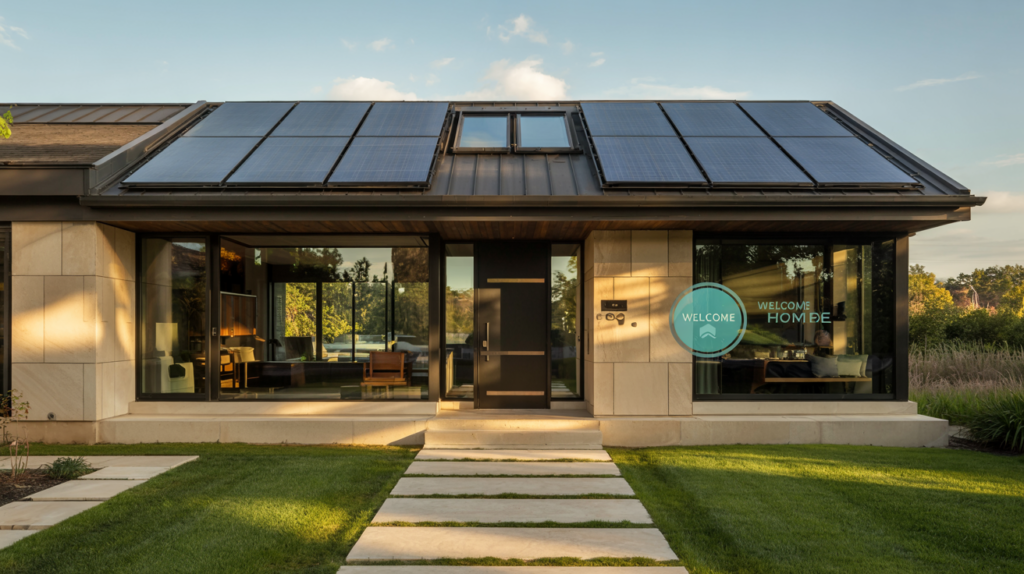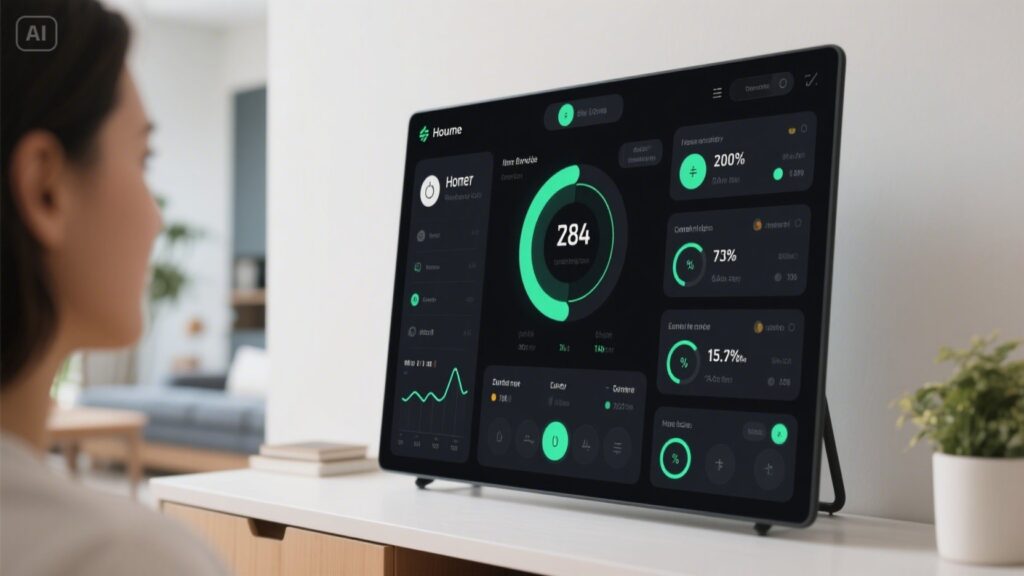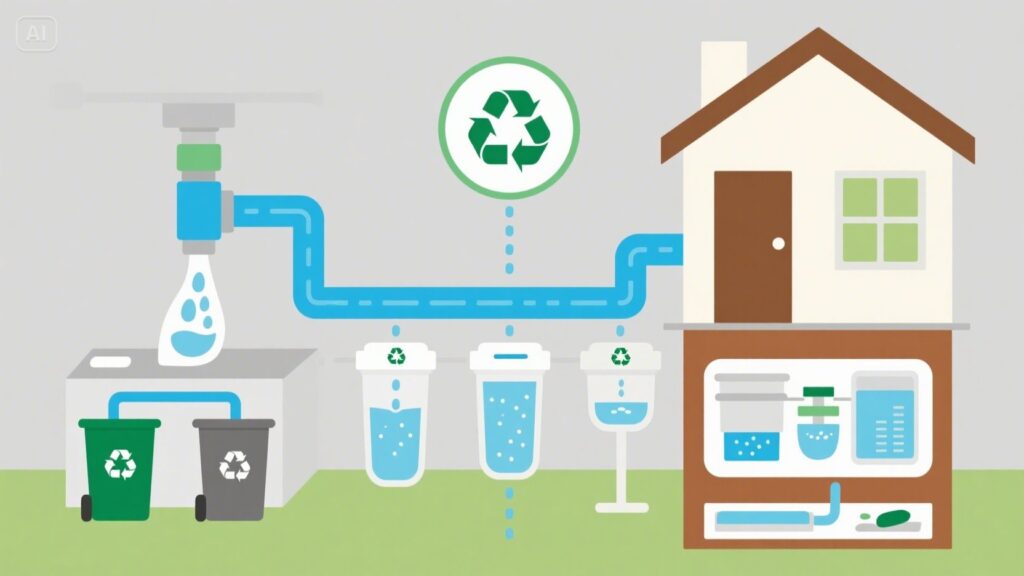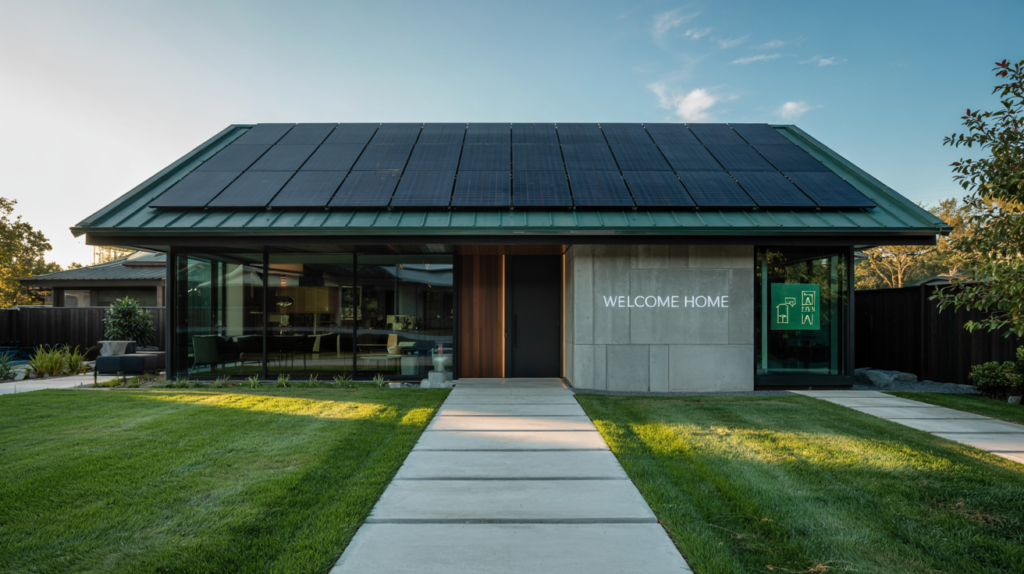Transform your living space into an environmentally conscious sanctuary with cutting-edge sustainable technologies that reduce your carbon footprint while enhancing comfort and efficiency.

Why Sustainable Home Technology Matters Now More Than Ever
As we navigate the challenges of 2025, homeowners are increasingly recognizing that their living spaces represent one of the most significant opportunities to address environmental concerns while improving quality of life. The convergence of climate awareness, technological innovation, and economic incentives has created the perfect conditions for a sustainable home revolution.
Today’s eco-friendly home technologies go far beyond the basic energy-saving measures of previous decades. Modern systems integrate seamlessly with our daily routines, often paying for themselves through utility savings while providing unprecedented comfort and convenience. Whether you’re building new, renovating an existing home, or simply looking to make targeted improvements, understanding these innovations can help you create a living space that’s both forward-thinking and responsible.
Smart Energy Management Systems: The Brain of the Sustainable Home
Integrated Home Energy Ecosystems
The most significant advancement in 2025’s sustainable homes is the evolution of comprehensive energy management systems that coordinate multiple technologies:
- AI-powered energy orchestration continuously analyzes usage patterns and automatically adjusts systems for optimal efficiency
- Predictive weather integration allows your home to prepare for upcoming conditions by adjusting heating, cooling, and energy storage
- Dynamic load balancing prioritizes energy use during peak demand periods
- Granular usage monitoring provides room-by-room energy consumption data
- Automated efficiency recommendations suggest behavioral changes and potential upgrades based on your specific usage patterns
Why it matters: These integrated systems can reduce overall energy consumption by 30-45% compared to traditional homes, creating substantial environmental benefits and utility savings. The most sophisticated systems coordinate between solar generation, battery storage, electric vehicle charging, and appliance usage to maximize renewable energy utilization and minimize grid dependency.
Implementation considerations: Look for platforms that offer open architecture and compatibility across multiple manufacturers. The best systems integrate with existing smart home standards rather than creating closed ecosystems, allowing you to incorporate different components as technologies evolve.

Next-Generation Solar Integration
Solar technology has matured significantly in 2025, with innovations making installation more accessible and efficient:
- Transparent solar windows generate electricity while maintaining visibility and natural light
- Solar roof tiles that are visually indistinguishable from traditional roofing materials
- Bifacial solar panels capture sunlight reflected off surfaces below the panel, increasing efficiency by 20-30%
- Building-integrated photovoltaics (BIPV) incorporated into facades, balconies, and architectural elements
- AI-optimized panel positioning that automatically adjusts orientation to maximize energy capture
Why it matters: These advancements allow solar integration into homes where traditional panels weren’t feasible, either due to aesthetic concerns, historical preservation requirements, or structural limitations. The improved efficiency and declining installation costs mean solar investments now typically pay for themselves in 4-6 years in most regions.
Implementation considerations: Before investing, conduct a comprehensive solar assessment that accounts for tree coverage, roof orientation, local weather patterns, and potential future changes to surrounding structures. Many utilities now offer virtual assessment tools that can provide preliminary estimates using satellite imagery and climate data.
Residential Energy Storage Revolution
Home battery technology has undergone remarkable improvement, creating new possibilities for energy independence:
- High-density lithium iron phosphate (LFP) batteries offer improved safety and longevity
- Stackable modular systems allow capacity expansion as needs change
- Vehicle-to-home (V2H) integration enables electric vehicles to power homes during outages
- Intelligent charge/discharge algorithms that factor in time-of-use pricing and renewable generation forecasts
- Second-life EV batteries repurposed for stationary home storage at reduced cost
Why it matters: Energy storage systems transform intermittent renewable generation into reliable power sources, allowing homes to maintain functionality during outages while reducing dependency on fossil fuel-based grid electricity. Advanced systems can reduce utility bills by 60-80% when paired with solar generation by shifting consumption away from peak-price periods.
Implementation considerations: Size your system based on both backup requirements and daily cycling needs. Consider future-proofing with expandable systems, and investigate utility incentive programs that may subsidize installation costs in exchange for grid stabilization services during peak demand periods.
Water Conservation Technologies: The New Frontier of Home Sustainability
Integrated Water Recycling Systems
Water reuse has become mainstream in 2025 homes, with compact systems that process and repurpose water from various sources:
- Greywater processing units filter shower and sink water for landscape irrigation and toilet flushing
- Rainwater harvesting with smart filtration collects precipitation for multiple household uses
- Atmospheric water generators extract moisture from air in humid climates
- Blackwater treatment systems for comprehensive on-site wastewater processing
- Closed-loop appliance systems where washing machines and dishwashers recycle their final rinse water
Why it matters: Integrated water systems can reduce municipal water consumption by 50-70%, decreasing both utility costs and pressure on often-strained regional water supplies. These systems provide particular value in drought-prone regions where water restrictions have become increasingly common.
Implementation considerations: Begin with simpler greywater and rainwater systems before considering more complex blackwater treatment. Most installations require periodic maintenance and water quality monitoring, so factor these ongoing requirements into your decision-making process.

Precision Irrigation and Landscape Management
Smart outdoor water technologies have transformed traditional landscaping approaches:
- Soil moisture sensors that provide real-time data to irrigation controllers
- Weather-integrated control systems that adjust watering schedules based on evapotranspiration rates
- Drip irrigation with zone-specific programming for targeted water delivery
- Root-level hydration systems that minimize surface evaporation
- Smart sprinkler heads that adjust spray patterns based on wind conditions
Why it matters: Outdoor water usage typically accounts for 30-50% of residential water consumption. Smart irrigation systems can reduce this figure by 40-60% while maintaining or improving landscape health by delivering precisely the right amount of water when and where it’s needed.
Implementation considerations: Begin with a comprehensive landscape water audit to identify existing inefficiencies. Group plants with similar water requirements together, and consider replacing high-water-need species with native alternatives adapted to your local climate conditions.
High-Efficiency Plumbing Innovations
Indoor water fixtures have seen remarkable efficiency improvements beyond simple low-flow designs:
- Recirculating shower systems that filter and reuse water during a single shower session
- Digital flow optimization faucets that adjust water pressure based on task requirements
- Ultrasonic dishwashing technology that reduces water use by 80% compared to traditional dishwashers
- Vacuum-assisted toilets similar to airplane systems but redesigned for residential comfort
- Leak detection systems with automatic shutoff capabilities to prevent water damage and waste
Why it matters: These technologies go beyond simple conservation, fundamentally rethinking how water is used in daily activities. Combined with behavioral changes, these innovations can reduce indoor water consumption by 30-50% compared to homes with standard efficient fixtures.
Implementation considerations: Prioritize upgrades based on your household’s highest water-use activities. Most homeowners find that shower systems and smart leak detection provide the fastest return on investment through water savings and damage prevention.
Climate Control Reimagined: Beyond Traditional Heating and Cooling
Geothermal Heat Pump Advancements
Ground-source heat pump technology has become more accessible and efficient:
- Compact vertical drilling systems require minimal yard disruption
- Hybrid geothermal solutions that combine ground-source with air-source capabilities
- Direct exchange systems that eliminate the need for intermediate heat transfer fluids
- Zoned geothermal distribution for room-by-room temperature control
- Monitoring systems that detect performance changes requiring maintenance
Why it matters: Geothermal systems can reduce heating and cooling energy consumption by 65-80% compared to conventional systems while providing superior comfort through consistent temperature delivery. Modern systems offer both heating and cooling capabilities, eliminating the need for separate equipment.
Implementation considerations: While installation costs remain higher than conventional systems, improved drilling techniques and federal tax incentives have significantly reduced payback periods, typically to 5-8 years. Consider “geothermal-ready” designs that allow for future installation even if immediate implementation isn’t feasible.
Dynamic Building Envelope Technologies
The boundary between indoors and outdoors has become increasingly sophisticated:
- Electrochromic smart glass that adjusts tint based on sunlight intensity and interior temperature needs
- Phase-change materials in walls and ceilings that absorb and release heat to moderate temperature swings
- Automated exterior shading systems that respond to sun position and weather conditions
- Thermally activated building surfaces that provide radiant heating and cooling
- Breathable wall assemblies that manage moisture while maintaining thermal performance
Why it matters: The building envelope represents the first line of defense against energy loss. Dynamic systems that respond to changing conditions can reduce heating and cooling loads by 25-40% compared to static high-performance envelopes, while often improving comfort by eliminating drafts and temperature variations.
Implementation considerations: Focus first on the highest-impact envelope components based on your climate: windows in most regions, insulation in extreme temperature areas, and air sealing in all locations. Many dynamic technologies can be added during window or siding replacement, creating natural upgrade opportunities.

Microclimate Creation Systems
Rather than conditioning entire homes, targeted systems create comfort where needed:
- Personal comfort devices that heat or cool individual occupants
- Occupancy-based zoning systems that adjust conditions only in used spaces
- Radiant floor and ceiling panels providing direct thermal comfort without air movement
- Computer-optimized natural ventilation that maximizes passive cooling opportunities
- Ceiling fan networks with coordinated operation for improved air circulation
Why it matters: Focusing conditioning efforts on occupied spaces and individual preferences can reduce energy consumption by 40-60% compared to whole-house approaches. These targeted systems also improve comfort by addressing personal preferences that whole-house systems cannot accommodate.
Implementation considerations: Begin with simple zoning solutions before investing in more complex systems. Smart thermostats with remote sensors provide an excellent entry point by detecting which rooms are occupied and prioritizing comfort in those areas.
Material Innovations: The Hidden Heroes of Sustainable Homes
Regenerative Construction Materials
Building materials have evolved to minimize environmental impact while improving performance:
- Carbon-sequestering concrete alternatives that store more CO₂ than their production releases
- Mass timber structural systems replacing steel and concrete in many applications
- Mycelium-based insulation grown from fungal organisms with minimal energy inputs
- Reclaimed material certification systems ensuring structural integrity of repurposed components
- Agricultural waste composite panels turning farm byproducts into building materials
Why it matters: Materials represent the “embodied carbon” in construction—emissions that occur before a building is even occupied. Regenerative materials can transform buildings from carbon sources into carbon sinks while often providing superior performance characteristics like improved insulation, moisture management, and air quality.
Implementation considerations: Focus on the highest-volume materials in your project for maximum impact. Many regenerative options now cost the same or less than conventional alternatives, particularly when considering their enhanced performance characteristics and durability.
Smart Materials with Adaptive Properties
A new generation of materials responds dynamically to environmental conditions:
- Self-healing concrete and sealants that automatically repair small cracks and damage
- Hydrophobic surfaces that reduce cleaning requirements and water consumption
- Photocatalytic coatings that break down air pollutants when exposed to light
- Thermal energy storage building components that stabilize indoor temperatures
- Color-changing materials that indicate structural stress or environmental conditions
Why it matters: Adaptive materials extend building lifespans while reducing maintenance requirements and improving performance over time. They create more resilient structures that can better withstand environmental stresses while continuously optimizing for current conditions.
Implementation considerations: Prioritize applications where material failures commonly occur in your region—roof membranes in areas with extreme temperature fluctuations, foundation waterproofing in wet climates, or exterior finishes in locations with intense UV exposure.

Circular Economy Building Systems
Construction approaches designed for eventual disassembly and material reuse:
- Component tracking systems that maintain material information for future recycling
- Mechanical fastening methods replacing chemical adhesives to allow clean separation
- Standardized modular dimensions enabling component reuse across different structures
- Design-for-disassembly documentation included with building plans
- Material passports detailing composition and potential reuse pathways
Why it matters: Traditional construction creates enormous waste during both construction and eventual demolition. Circular approaches treat buildings as material banks, preserving resources for future use while often creating more adaptable structures that can evolve as needs change.
Implementation considerations: Even if complete circular systems aren’t feasible for your project, incorporate principles where possible: choose mechanical fasteners over adhesives, select materials with established recycling pathways, and document your building’s material composition for future reference.
Implementation Strategy: Making Sustainable Technology Choices
Assessing Your Home’s Unique Needs
Before investing in specific technologies:
- Conduct comprehensive energy and water audits to identify your highest-impact opportunities
- Analyze local climate conditions to prioritize appropriate solutions
- Establish your sustainability priorities (energy, water, materials, or a balanced approach)
- Consider your long-term occupancy plans when calculating payback periods
- Evaluate local incentive programs that may reduce costs for specific technologies
Creating a Phased Implementation Plan
Few homeowners can incorporate all relevant technologies simultaneously:
- Begin with low-cost, high-impact improvements like smart thermostats and water leak detection
- Coordinate major upgrades with natural replacement cycles for equipment and materials
- Design systems with expansion capabilities for future technologies
- Install necessary infrastructure (like conduit for future wiring) during any renovation projects
- Prioritize improvements that address multiple sustainability categories simultaneously
Finding Qualified Professionals
The success of sustainable technology often depends on proper installation:
- Look for contractors with specific certifications in renewable energy, green building, and water systems
- Ask for references from similar projects they’ve completed
- Ensure they understand the integration requirements between different systems
- Request detailed commissioning processes to verify proper function after installation
- Consider maintenance contracts for complex systems requiring regular professional attention
The Future is Now: Taking the First Steps
Creating a more sustainable home doesn’t require implementing every technology mentioned here. Begin with a thoughtful assessment of your specific situation, focusing on the areas where improvements will provide the greatest environmental benefit and personal value.
Remember that sustainable technology continues to evolve rapidly, with new options emerging regularly. Design your improvement strategy to accommodate future innovations, focusing on flexible systems rather than closed ecosystems that may become obsolete.
Most importantly, view your sustainable home journey as an ongoing process rather than a destination. Each improvement builds on previous efforts, creating cumulative benefits that extend far beyond your individual household to impact the broader environment we all share.
What sustainable technologies are you most interested in implementing in your home? Share your experiences and questions in the comments below—we’d love to hear about your sustainability journey!

